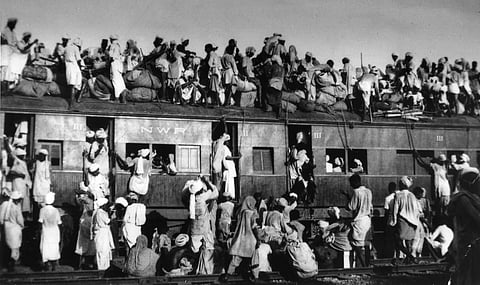
- HOMEGROWN WORLD
- #HGCREATORS
- #HGEXPLORE
- #HGVOICES
- #HGSHOP
- CAREERS
- ABOUT US
- CONTACT US

After almost a three-hundred-year rule in India, The British left the subcontinent in August 1947. But before they left the subcontinent they partitioned it into two independent nation-states: Hindu-majority India and Muslim-majority Pakistan. The ripples of such an event are still felt even after 76 years and have forever changed the political course of these two nations. With the partition came one of the greatest migrations in human history, as millions of Muslims trekked to West and East Pakistan (now known as Bangladesh) while millions of Hindus and Sikhs headed in the opposite direction. Thousands of people never made it and millions more were uprooted from their homes or become victims of sectarian violence.
The Partition of 1947 was not the only partition owing to British rule. What followed was the partition of Pakistan to create Bangladesh after the Bangladesh Liberation War in 1971, the ongoing and unresolved conflict in Kashmir dating from 1947 onwards, which has unofficially partitioned Kashmir into several distinct zones, the partition of Burma in 1937 (now known as Myanmar), the partitions of Bengal in 1905 and 1947; and the partition of Assam and the Northeast in 1947. All of these subsequent partitions can be traced back to our colonial history.
Despite the extensive loss of life and property, almost 70 years later there existed a severe void that no museum or memorial existed anywhere in the world to remember all those millions until the inauguration of The Partition Museum in the town hall of Amritsar, Punjab, India on 25 August 2017. It is the world’s first partition museum. This public museum is a central repository of memories in the form of stories, materials, and documents related to the post-partition riots that followed the division of the subcontinent. Its collection houses, refugee artifacts, art, archival materials, and oral history.
In the 2018, Riturparna Roy’s Kolkata Partition Museum Project was registered which captures Bengal’s partition history and its aftermath. The museum emphasizes the continuities between West Bengal and Bangladesh in terms of language and literature, food, fabric, and the performing arts and encourages collaboration between them. Its aim is to involve public participation in its programs and put together all its activities in a way that makes them more accessible to the public at large. The project’s vision is to capture rupture and continuity — two sides of the coin of Partition. They launched their first virtual museum tour on August 2022 to mark 75 years of Independence. The virtual museum’s three main components are ‘Event Galleries’, an ‘Oral History Project’, and a ‘Virtual Art Gallery’. It has archival, audio/visual, and literary sections that a traditional museum has, but all of this is augmented through the virtual environment.
On February 2, 2023, The American Alliance of Museums, a non-profit organization, launched the Online Partition Museum, a virtual museum of art dedicated to memorializing and raising awareness about the partitions of the Indian subcontinent through innovative visual art exhibitions. The Online Partition Museum takes a holistic view of the fractured geopolitics of the Indian subcontinent and its aim is to reveal the deep and often invisible interconnections between these intertwined partitions that are set apart by time and space. Its objective is to educate and reach South Asian and non-South Asian audiences. The team comprises artists and scholars in the fields of Visual Art, Partition Studies, Memory Studies, Trauma Studies, and Feminist Historiographies.
"Where should a Partition museum be? It should be a virtual museum so that everybody can contribute, so you don't have to physically go to a place in one of these countries, because then always there will be the dominant narrative, and we don't want a dominant narrative. We want a balanced narrative which sees all aspects of all the partitions. And therefore, I like the idea of a virtual museum. That would be the museum to actually pursue, where you could have all of our stories in a virtual museum that spans the continents, and does not acknowledge any divides.
Salima Hashmi, artist, curator, activist, and cultural leader based in Pakistan
